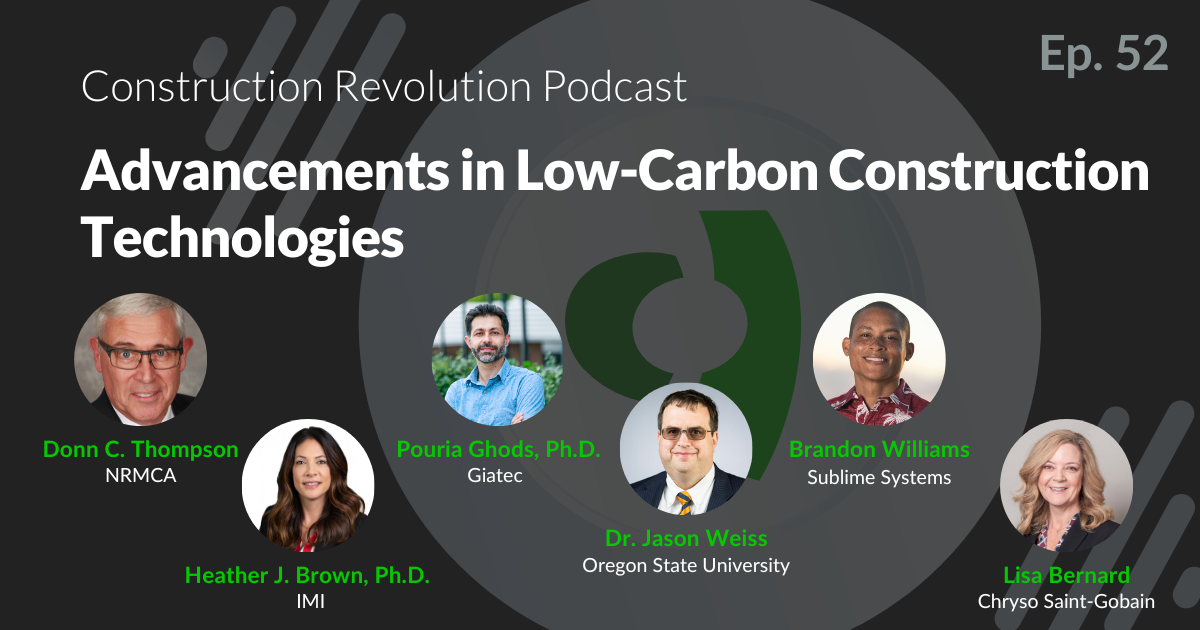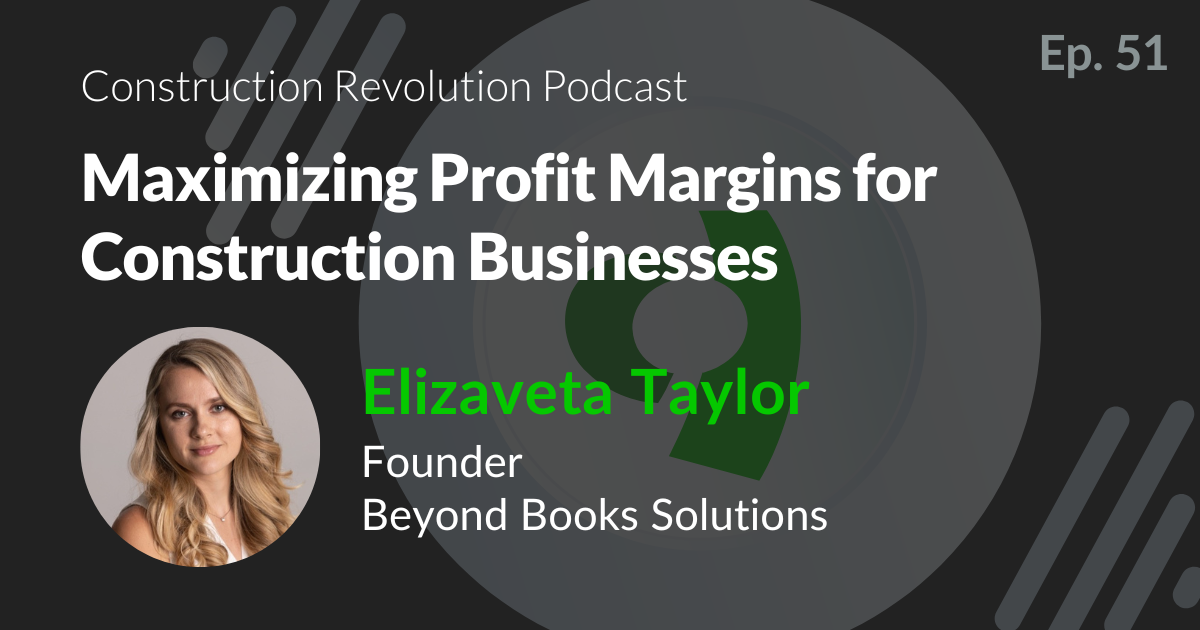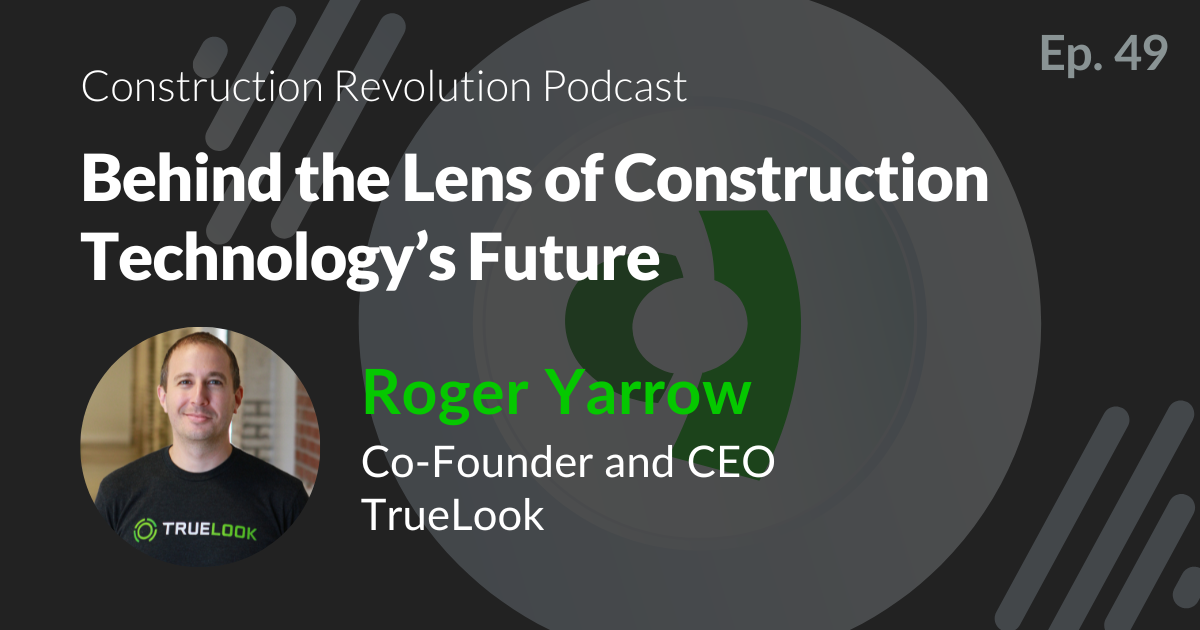
Episode 18 |
March 8, 2022
The Evolution of Software Within the Construction Industry
In This Episode
In this episode of the Construction Revolution podcast, we sit down with Paul McKeon, founder and CEO of BTW Software. Paul founded the company that would become B2W in 1993, introducing the first estimating application for DOT paving projects followed by the first heavy construction estimating application built from the ground up for the Windows environment. He explains BTW’s One Platform, which includes tools for estimating and bidding, scheduling and dispatching, field tracking and analysis, equipment maintenance, as well as safety and inspections. Join us as he describes how he has grown his company from his garage and its original DOS program to the success that it is today. Learn how you can use software to connect all aspects of your project to improve efficiency and performance.

Host
IAN WRIGHT
Content Marketing Manager, Giatec Scientific Inc.

Guest
PAUL MCKEON
Founder and CEO of B2W
Podcast Transcript
Ian Wright:
Hello, and welcome to the Construction Revolution Podcast, where we explore the trends, technologies, organizations, and people that are changing what the construction industry will look like tomorrow. I’m Ian Wright and today I’m joined by Paul McKeon, founder and CEO of B2W Software. B2W offers a unified estimating and operations software platform for heavy construction. The one platform includes tools for estimating and bidding, scheduling and dispatching, field tracking and analysis, equipment maintenance, as well as safety and inspections.
So just to start, Paul, can you give us a bit of a company history? What was the vision when B2W was founded all the way back in 1993?
Paul Mckeon:
Sure. Well, the vision then I was working on my own out of my home on a $12 card table as the story goes and a small Compaq Presario computer. And I think, candidly, interestingly, the vision then was to be able to buy groceries and pay my mortgage. It’s interesting. The vision for the company has changed really significantly at every step along the way. But back then I basically had built a DOS based program that was used for primarily companies that did road and paving type construction. And it was sold initially just out of the New England area or in the New England area.
And as time went on, it became clear that certainly Microsoft Windows was emerging as the new standard for desktop computing. And there was an effort to take that initial DOS based program and build it over again in Windows, which we did. And with that, we launched that program. We, being myself and one or two other fellows, launched that program nationally and really had some pretty good success that I think there was a major focus on ease of use and simplicity. It was a program that if you were looking at other professional Windows based programs, looked consistent with what you’d expect. So a big focus on intuitiveness and ease of use.
And at that time, the focus was pretty much that initially, but the more success we had in North America, we began to certainly understand that there was a need for a tool that would go well beyond just kind of construction or paving and road construction, a tool really that would service the entire infrastructure, heavy civil market. And so an effort was begun at the end of the… I guess it was probably maybe 98 to build a tool that would replace the initial tool and be more suited for really all aspects of heavy civil construction. And that program was launched, I think it was launched in 97. It could have been 98 and that was bid to win. And that product was met with really great success. It was a product that was very, very easy to use, very powerful, very flexible. And it was up against then companies that had made perhaps not such a gracious transition from DOS to Windows.
And so we really started to have tremendous success with that product. It became obviously the bellwether product for the company and at a certain point in time, as we got larger and larger companies on the product, we realized that the product would need to be rebuilt in a more enterprise class, more robust platform, the original platform being actually Microsoft Access. And so an effort was begun in 2001 to redo what we had done in Microsoft.net and SQL server, which were then and still are certainly very, very powerful enterprise class tools. And that ultimately led to, in 2000, I believe it was 2006 or seven, the release of a whole new generation of our software. And that was really a significant turning point for the business because certainly our customers were looking forward to it, but the market was aware that we were doing it and that no one else really was.
And so it was the beginning of really great success for the company. And as time moved on, we became aware that customers wanted more than just estimating. They wanted tools that would help them track labor and equipment usage in the field, on their projects, be able to track production quantities against phase codes, et cetera. So we began an effort to build that product. And in the years that have passed since, we’ve really listened to the market and built something very unique, which is an operational platform that supports five or six different specific operational workflows outside of the accounting, the financial accounting realm that span obviously estimating and bidding tracking in the field for the projects that are ongoing, scheduling logistics, equipment maintenance and repair, and a very powerful tool that lets companies essentially go paperless to capture information on things like safety reports and so forth. So that would be the treetop vision of the history, how the vision changed and kind of where we’re at today.
Ian Wright:
That is a lot. It’s incredible to see software going from DOS, starting in DOS and then ending up where it is today. I’m curious, I mean, obviously there’s been a lot of changes on the software side, but in terms of your customer’s perspective, what changes have you seen in the construction industry over those sort of past 30 years?
Paul Mckeon:
Yeah, that’s a great question. I think what’s happened in the construction space is the construction space in general is kind of a technology laggard. And I think the transition has been that folks have really embraced the use of technology to gain greater efficiency and drive higher profitability in their business. Many years ago, when I first started kind of the tool of choice for construction was Microsoft Excel. It didn’t really matter what it was, Excel was the answer. And I think people as tools became available and became more advanced, have really embraced the fact that tools that help drive efficiency, professionally written tools that drive efficiency and productivity are really not just nice to have, but frankly, in a margin pressured space like construction, tools that you really must have in order to be able to compete and be viable.
Ian Wright:
That’s interesting. So you feel like there’s less education, say of the customers or less of an uphill battle maybe to get them to see the value of the product?
Paul Mckeon:
Yeah, I think there really is. I think that there was a lot of anxiety early on with… Products were not this necessarily easy to use, technology was new, to some degree were folks that weren’t really that familiar with technology. There was a bit of fear there and I think the other transition has been that certainly, more recently younger folks are coming into the market. They’re working for companies, their generation now has an expectation around the need to use laptops and tablets and smartphones, and really be able to do their job, if you will, using technology. So that’s really kind of, I think, brought it full circle, but I think people are less needing to be educated about why they needed and more interested in learning why one particular provider may have a better option for them than somebody else.
Ian Wright:
Sure. Yeah. That makes sense. So, what can you tell us about the products that you’re offering right now and the needs that they’re addressing?
Paul Mckeon:
Sure. So basically, again, everything is outside of the realm of natural accounting. And I think our first tool that I would mention would be estimate and the B2W Estimate product is designed to help companies build very detailed cost based estimates and to do it efficiently, to do it quickly and to do it accurately. These bids are often very, very detailed, they involve in many cases, for example, when it’s DOT work can be hundreds and hundreds of line items of work, a lot of it’s subcontracted, the detail work that they do on their own is, there’s a lot that goes into it with crews and production and a work breakdown structure that helps them support, really getting into the nitty gritty about how they would go off and approach doing the work.
So I look at it as an estimate is really a forecast of profitability. And so it’s the key element that needs to be passed to the field. If you’re successful with a job, you have to be able to bid it. I should say, do the work, complete the work in a way that’s consistent with the estimate. So the next phase of it would be taking a project that you win and using B2W Track and being able to go off and essentially capture on a daily basis, the labor usage, the equipment usage, material usage, subcontractors, trucking, and so forth, the production on the phase codes. And to be able to see as a foreman, as you enter that information in, how is that comparing to the estimate? Am I on track? Am I not on track? And then of course, being able to pass all that information through, say the tablet or the single mouse click to the office, which then lets management be able to to see what happened yesterday, how do we deal on the various projects?
Being able to look at individual jobs, parts of jobs and see whether there could be something going on, maybe today was great or not so great, but how does that compare to the rest of the job? So that gives them a more timely way to be able to make adjustments, to make sure that they’re keeping the job on track. And obviously the buy product of that and using the tablet is being able to capture all the payroll. The payroll with the single mouse click is passed through accounting. So it’s really allowing them to capture the information and make more real time decisions around what needs to be done on the job to keep it on track from that point or in conjunction with that, you would be using a tool like B2W Schedule, which is allowing the team in the office to schedule the work.
Where will the crews go, which equipment needs to be moved where and when and which low beds our own subcontracted, et cetera. And again, making sure that they’re moving everything to the field and communicating with the field around what’s going to be going on tomorrow, the following day and so forth. And then you have a course equipment maintenance and repair, a really critical aspect of every business is the ability to maximize uptime of your construction fleet and folks that use a tool like B2W Maintain or are driving a much higher degree of uptime for the equipment, driving their cost down significantly. And these tools all collectively as well are letting folks understand what equipment is in the field. What equipment are we renting? Is there equipment that we’re renting that is sitting on projects unused? And all that information is captured automatically behind the scenes using telematics.
So you start to see how everything is kind of working with everything else to create the maximum amount of information and data to make good decisions. And I would say last but not least would be B2W Inform and Inform is a very exciting platform that allows companies to build their own electronic forms and be able to go into the field and essentially capture data for things like safety, and to be able to pass that back to the office and then run all kinds of metrics and reports around something like safety. But the real benefit there is all of that data is accessible and can be used to drive all kinds of industry metrics, KPIs, and so forth. So again, overall the plan or the goal is to essentially allow a company to much more efficiently and effectively run the operational aspect of their business.
Ian Wright:
It sounds very comprehensive. I mean, you’re talking about sort of covering your job site, everything from the estimates all the way up to keeping track of your equipment and making sure it’s maintained properly. I’m curious, I mean, having all of your data in one place it’s easily accessible. It’s an ideal for pretty much any data driven business, but I think everybody knows it’s sort of easier said than done. So I’m wondering about how B2W specifically deal with the challenges of interoperability?
Paul Mckeon:
That’s a great question. I think at the end of the day, the major differentiator for B2W Software against all of the players in the market is that the other players in the market essentially have a group of four, five, six disparate individual Windows based products in which you are managing one of the workflows that I just mentioned. And the problem with that is that it’s impossible to keep everything consistent. For example, if you’re using one tool that requires a list of current list and up to date list of employees and an up to date list of equipment, et cetera, having to manage that in three or four or five different products at the same time is virtually impossible. So it leads to a tremendous amount of bad data and bad information.
What’s different about B2W is that we offer an operational platform that is essentially browser based. No software has to be installed on any computer. And those workflows that I mentioned are being supported by one single database of the resources that are needed to support those workflows, the laborer employee list, the equipment list, the job list, the phase code and the jobs, everything operationally that’s needed to support those workflows is in one single spot and shared by all the workflows, not disparate, not disconnected. And that is a tremendous, tremendous benefit. And I think it really is the main driver for our emergence as the market leader.
Ian Wright:
Okay. So let’s talk about regulation then. I mean, construction is obviously it’s a highly regulated industry. Is regulation ever a hurdle for you? How do you deal with that?
Paul Mckeon:
Regulation really is not so much a hurdle for us, the only time that regulation comes into play to some degree is if there’s some type of a form or something of that nature, that’s required for a company to fill out in the field on a project, but it really doesn’t impact the software so much. Obviously we make changes as needed to the software to address something that may be unique, but it’s not really a big factor in terms of the developer of the software.
Ian Wright:
Obviously everyone felt the effects of the COVID-19 pandemic, construction industry certainly no exception. I’m curious, what have you been seeing at B2W?
Paul Mckeon:
I think there’s been a lot of anxiety in the construction market, obviously around COVID on many, many different fronts. Working from home is not ideal, but I do think that people have come to the point where we’ve weathered that storm, I think there’s light at the end of the tunnel. And I think people are very excited to really get back full swing to working operationally in the office as a team and going out and taking advantage of a lot of opportunity that’s really emerging with Federal Funding of infrastructure projects and so forth. So I think we’re over the worst of it. I think a lot of the anxiety has settled and I think people are ready to kind it back to work as normal.
Ian Wright:
What do you think is the biggest driver of revolution in the construction industry today?
Paul Mckeon:
Well, certainly absolutely technol, and I think what’s interesting is that we’ve transformed from an industry where there have been a lot of companies with a lot of different solutions that are disparate. And I think that the product has, or I should say the industry has matured where the people are more educated. The products that are now available are more sophisticated. And I think that the more educated people become and the more sophisticated the tools, it’s really an opportunity to bring construction, the construction market full circle with fully embracing technology. And as I mentioned earlier, the construction space is margin pressure. And if you don’t have control from a costing perspective and an operational efficiency perspective, you’re not going to be competitive. So I think the biggest driver, well, it has been in the last 10, 15 years technology.
And I think it will continue to be, but I think it will grow exponentially because there’s technologies advanced, years ago it was DOS and anything in DOS was fantastic. And then Windows kind of came onto the scene. And that was fantastic. And then we got into tablets, which I think early on people, weren’t sure that was going to really take hold commercially, but it certainly did, smartphones and the tools that capture information on job sites and the tools that are now becoming available to more efficiently run things. It’s really quite amazing.
Ian Wright:
Yeah, it is for sure. All right. Paul McKeon, founder and CEO of B2W Software. Thanks very much for joining us.
Paul Mckeon:
My pleasure. Thank you.
Other Related Episodes
Episode 52 |
November 14, 2024
Advancements in Low-Carbon Construction Technologies
Join us for an engaging and insightful panel discussion from 2024 Net Zero Construction Conference, hosted by Aali Alizadeh, Ph.D., Co-Founder and CTO of Giatec and Technology Chair of The Net Zero Construction Conference. This episode dives into groundbreaking advancements in low-carbon construction technologies, highlighting both the promising opportunities and the significant challenges involved in their industry adoption.
Our distinguished panel of experts features: Professor Jason Weiss from Oregon State University, Heather Brown, Ph.D., Vice President of Quality Control/Quality Assurance at Irving Materials Inc. (IMI), Donn Thompson, Senior Director of Building Innovations at the National Ready Mixed Concrete Association (NRMCA), Brandon Williams, Business Development Manager at Sublime Systems, Lisa Barnard, Sustainability & EPD Program Manager at Chryso Saint-Gobain, and Pouria Ghods, Ph.D., Co-Founder and CEO of Giatec. Together, they offer a wealth of knowledge on the latest advancements in sustainable construction, sharing how innovative materials and solutions are transforming the industry.
Don’t miss this opportunity to learn from industry leaders as they share actionable insights and strategies that can drive meaningful change in the construction landscape.
Want to dive deeper into conversations like the ones in this episode? Join us at the Net Zero Construction Conference 2025 on March 19-20 in the Virbela Metaverse! Experience two days of expert panels, innovative insights, and networking opportunities focused on low-carbon construction technologies. Learn more and get your tickets on the N0CC website!
PLAY
Episode 51 |
October 24, 2024
Maximizing Profit Margins for Construction Businesses
In this episode of The Construction Revolution Podcast, Steven Rossi sits down with Elizaveta Taylor, founder of Beyond Books Solutions. With extensive experience in construction accounting and advisory services, Elizaveta is dedicated to helping construction business owners save time, money, and increase their profits. Tune in as Elizaveta discusses the common financial challenges faced by construction companies, shares strategies for maximizing profit margins, and offers expert advice on cash flow management. From overcoming money mindset blocks to optimizing QuickBooks for construction businesses, this episode is packed with valuable insights for anyone looking to improve the financial health of their construction business.
PLAY
Episode 49 |
September 12, 2024
Behind the Lens of Construction Technology’s Future
In this episode of The Construction Revolution Podcast, Steven Rossi sits down with Roger Yarrow, CEO and Co-Founder of TrueLook Construction Cameras. With over 25 years of experience in technology and leadership roles at industry giants like IBM and Xerox, Roger is at the forefront of innovation in jobsite visibility solutions. Tune in as Roger shares the story of TrueLook, discusses the latest trends in construction technology, and reveals how advanced camera systems and comprehensive surveillance solutions are transforming jobsite management. Whether you're interested in theft prevention, time-lapse documentation, or integrating cutting-edge technology into your projects, this episode offers valuable insights into the future of construction.
PLAY
Want to Be a Guest Speaker, Sponsor, or Just Have a Question for Us? Fill In the Form!




